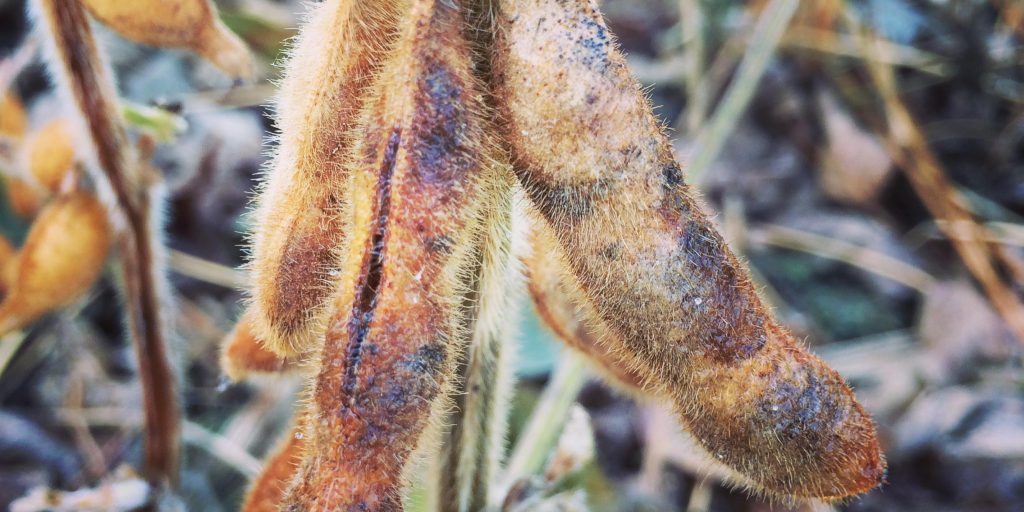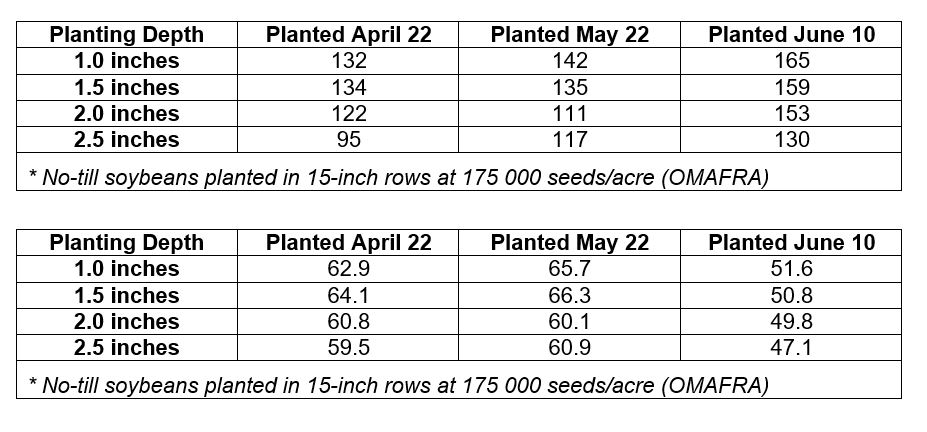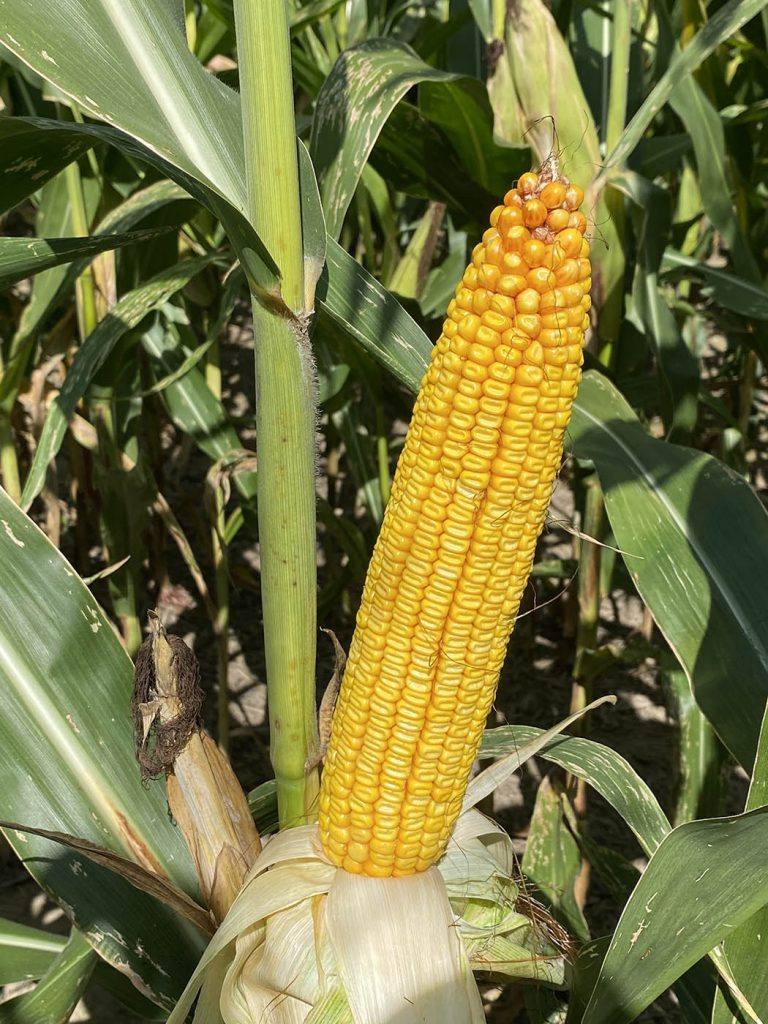Field observations
2020 IN REVIEW

January 8, 2020
As harvest has wrapped up, we will be sharing a summary of the crop highlights by commodity over the coming weeks. This final week we look at soybeans.
In general, 2020 soybean planting began much earlier with majority of acres completed earlier than they were in 2019.
The second half of April and the beginning part of May brought ideal conditions for planting. A question arose. If the soil is fit, should you plant soybeans or wait in such an early year? In terms of the soil temperature question, it was found that soybeans are much tougher than we may give them credit for.
As noted in previous year end updates, many parts of Ontario experienced snow and very cold temperatures around the middle of May. Soybeans that were planted close to or during the very cold conditions had stand and pods counts similar to those that were planted later when it was warmer. Sometimes there was a reduced stand in some places, but it was seen that the early planted soybeans had time to branch and filled out as the year progressed. Essentially there was found to be no loss in yields, but also no gain in yields that were planted early in the cooler areas.
One thing that did have an impact though was residue management. If farmers were no-tilling into a thick corn mat very early in the season, that did, in some cases, cause some challenges. Soybeans that really struggled this past spring were planted into poor conditions, namely soils that were too wet at planting causing issues such as crusting, seedling disease, and root disease. There were some replants, some due to cold maybe, but most due to the conditions they were planted into.
Research trials by the Ontario Ministry of Agriculture, Food and Rural Affairs (OMAFRA) in 2020 found that planting depth for soybeans is extremely important. It was found, on average, that planting at a depth of 1.5” showed the most consistency for yields.

Weather at the end of June and July was quite dry. It is known that an early dry start can be positive in that roots search for moisture. With dry conditions there was overall less root rot across the province.
In August, there were some million-dollar rains for most areas of the province, which really helped with final yields. August was not without its troubles though. Spider mites made an appearance and caused some damage. Spider mite damage commonly looks like drought damage, so farmers really need to get out into the field and scout to see what is causing the issue. Don’t just assume it is a moisture issue. Areas that did get large rains at the end of the summer saw some phytothera root rot, fusarium wilt, phomopsis seed decay, and purple seed stain which were a direct result from the high rains.
Weed control was a bit of a challenge in some areas throughout the year, dry weather caused some herbicides not to activate early on in the season. In other areas, some crops were stunted causing weeds to emerge without much competition. Waterhemp was one of the tougher to control weeds. Learn more about this troublesome weed here.
Harvest saw cooperative weather across most of the province. With high bean counts and high pod counts, some farmers reported it was the best crop that they had ever had, with record breaking yields.
2020 yields from Statistics Canada put average Ontario soybean yields at 50.7 bu per acre, with a total seeded acreage of 2,850,200 acres.
Research
Grain Farmers of Ontario has more than 200 funded research projects listed online. One of the past projects that has been supported is “The interaction between soybean seed isoflavones and soybean cyst nematode resistance” by Milad Eskandari. The results of this project identified significant genotype, environment, and genotype-by-environment interactions for isoflavones. Lower seed isoflavone concentrations were observed in SCN-resistant and non-SCN lines planted in SCN infested environments when compared with the results from non-infested environments, which could be due to preferred isoflavone accumulation in the roots in the presence of SCN, thereby reducing isoflavone accumulation in the seeds (Carter et. al., 2017 & 2018). Within SCN infested environments, resistant genotypes had significantly higher isoflavone concentrations than susceptible genotypes. A strong positive relationship between the level of resistance to SCN and relative yield was observed among the genotypes in SCN environments (i.e., higher yields from genotypes with higher levels of SCN resistance). Stable cultivars with increased isoflavones have been identified and will be advanced to Ontario Soybean Trials across southwestern Ontario for final evaluations and commercial release. The identification of stable high isoflavone lines with resistance to SCN indicates the possibility of development of food-grade soybeans with elevated isoflavones.
For more information on this project, or others visit our Research Projects page.
December 18, 2020
The 2020 growing season brought unique challenges for all commodities. In this week’s summary, we look at highlights of the corn crop.
Corn
The weather was relatively dry but on the cooler side in April. A small amount of corn acreage was planted in late April where conditions were fit. The first week of May brought great planting conditions and a lot of corn went in the ground in much better shape than most corn in 2019. In general, the old rule of thumb was to avoid planting just before a cold rain shower as chilling injury can occur as cold rain shocks the seed and can reduce seedling vigour and stand establishment. Well, right after planting, May 8 – 11 saw unusually cold conditions arrive with snow and temperatures well below 0° C. Snow and cold temperatures lowered the soil temperature and in some of the finer texture soils the soil seemed to harden and compact through this wet spell. The weather turned around in later May and corn planting finished in early June.

The cold weather in May didn’t a have dramatic effect on the April planted corn, but did lower the population and created stress for the germinating seed in the early May planted corn. The experience this spring showed that the crop can take cold weather once it is past the initial germination stage, but not in the initial days of germination. Stress in the early stage can cause the emerging tissue to lose its bearings and corkscrew around until warm temperatures increase growth activity.
Once conditions in late May turned around, farmers and agronomists were assessing plant stands as they were coming through the ground. Corn from west to east fared well and establishment was great. In southwestern Ontario, corn was replanted from the early May planting period and lots of rotary hoes were used that had not seen light in many years. Actual sales of rotary hoes had a huge jump this spring. In the future, we will be looking a lot closer at the two-week forecast. If no crop units are forecasted, we will know to wait for the next warm break as late planted corn had perfect stands and ended up with higher yields than the stressed low populated corn.
Grain Farmers of Ontario supported the Ontario Ministry of Agriculture, Food and Rural Affairs’(OMAFRA’s) nitrate survey in June. Survey results spanned across the province and showed nitrate levels to be mostly normal, and maybe even slightly above normal. This could be due to the hot, dry weather in the later part of June which helped nitrate availability in the soil.
Pruned roots and goosenecked corn were found in several counties this summer, a direct result of corn rootworm resistance. The number one method to prevent resistance to corn rootworm in your field is to rotate your crops! Farmers who plant corn on corn for two years are at moderate risk to developing resistance and those who plant corn three years in a row are at a high chance of developing resistance. Grain Farmers of Ontario will be hosting a Farmer Forum in the New Year on corn rootworm to help answer your questions and foster farmer dialogue on this resistance topic.

Well needed rains in August helped with grain fill. The DON survey conducted by OMAFRA in September, with support from Grain Farmers of Ontario, found low DON numbers across the province, with a few spots showing moderate infection. The DON survey results can be found here. As this was just a moment in time at random fields, it did not forecast the few hot pockets that showed up later in the fall as weather conditions became damp and cool, ideal conditions for DON development. Later planted fields along the Lake Erie shoreline seemed to have been more affected.
Tar spot was found for the first time in Canada this fall, Chatham-Kent was the first location and then in surrounding counties. For more information on tar spot please see our Tar Spot Agronomy Alert and this Ontario Grain Farmer article.
The 2020 harvest saw some nice stretches of dry conditions to allow harvest to continue at a steady pace. As weather cooperated a lot of corn came off at good moistures. In general, most farmers were pleased with the yields and test weights considering the conditions many went through. Dry weather in the east and through Niagara, wet in the south, but in-between there were some ideal pockets that worked out just right.
Seed purchasing is still in full swing. The Ontario Corn Committee Trials are posted for 2020. Trials span across the province and can be a valuable tool for choosing seed. Please refer to our fact sheet on choosing the right seed for helpful hints when purchasing seed for the upcoming season.
Research
Grain Farmers of Ontario has more than 200 funded research projects listed online. One of the past projects that has been supported is the “Determination of a sugarcorn to ethanol and co-products value chain” by Brandon Gilroyed. The study looked at identifying a farm management system for sugarcorn that would produce optimum biomass and sugar yield and help establish the on-farm viability of the proposed sugarcorn value chain. For more information on this project, or others, view our research project summaries.
December 11, 2020
The 2020 growing season brought unique challenges for all commodities. In this week’s summary, we look at highlights of the spring cereals crop
Spring Cereals
This past spring began quite well for spring cereal planting, with a warm spell in late March and early April. An early window of weather allowed the majority of spring cereal acres to be planted, in ideal conditions, prior to the arrival of cold temperatures and snow in early May. The cold streak certainly slowed down growth and caused some concerns on survivability. But most spring cereals were still at a stage that they could handle the cold, without any major detriment to plant stand.
According to Statistics Canada, 104,500 acres of oats were seeded across the province; 89,900 acres of barley were seeded; 116,500 acres of spring wheat were seeded; and 68,900 acres of mixed grain were seeded.
The beginning part of the growing season, up until about July, saw very low disease across the province. Some areas that had regular rainfall did see some disease pop up on oats and barley (net blotch and crown rust) that did, in some cases, require control.
This year was a year for insects and bugs. Cereal leaf beetles, cereal aphids, and army worms were found in pockets across the province. Local agronomists and farmers did a great job communicating locations of higher population areas and managing for these pests.
Harvest was delayed slightly by rain in August; but, overall quality remained good. According to Statistics Canada, the average yield for Ontario barley in 2020 was 61.8 bushels/acre (bu/ac); for oats, 72.6 bu/ac; and for spring wheat, 47.3 bu/ac.
Oat and spring wheat yields were lower than the five-year average. Hot, dry weather occurred during the grain fill period, shortening the grain fill period and reducing the kernel size. In especially dry areas, the stress reduced kernel counts by aborting kernels.
Cover Crops
Registration is now open for the Midwest Cover Crops Council Conference taking place online February 23-25, 2021!
The Midwest Cover Crop Council Conference is being hosted by Ontario this year and will have a uniquely Ontario flair to it. Be sure to join the conference to hear two keynote presentations – “Finding Common Ground on Cover Crops” and “When More Isn’t Better”. The conference has many other sessions including from “Knowing what we don’t know about soil biology”, “Cover crop and cash flow”, as well as “Cover crop troubleshooting”. The conference will be a fantastic opportunity for farmers, researchers, and others interested in cover cropping and soil health, to exchange learnings and share expertise.
Visit the conference website to preview the agenda and register for what is shaping up to be an amazing event!
Research
Grain Farmers of Ontario has more than 200 funded research projects listed online. One of the past projects that has been supported is “Genotype x Environment interaction for oat grain fill” by A.R. McElroy. The conclusions were 1) Early-season stress is a major factor responsible for the presence of unfilled kernels. Extreme cases can result in complete crop failure, with no filled grain in a normal looking crop. 2) There is extensive genetic variation for resistance to this stress, but there is also a significant genotype x environmental interaction.
For more information on this project, or others, click here.
December 4, 2020
As harvest has all but wrapped up, we will be sharing a summary of the crop highlights by commodity over the coming weeks. We start this week with a look at winter wheat.
Winter Wheat
The 2020 winter wheat crop was planted under relatively good conditions with the majority of the province having wheat planted by mid to late September 2019. The remaining crop was completed by mid-October to late October. Crops had a good start in the fall with good root growth that set up the plants to head into winter in optimal conditions. Much like the 2021 wheat crop that was planted this fall.
For 2020 wheat, planting date played a significant role in the management required in individual fields. Scouting was critical in order to make the best management decisions. In early spring, there were some reports of farmers facing up to 30 per cent stand loss due to heaving in heavy clays, and in fields with poor drainage, ponding and ice coverage lowered plant stands. Although, for the most part, wheat came out of the winter in fairly good shape.
The cooler spring allowed for more vegetative plant development allowing for more time to build tillers and develop better plant canopies. Early May brought some snow and freezing temperatures, which slowed growth significantly in many regions, particularly in root growth. The limited access to nutrients resulted in purple plants and caused concern for many farmers.
One learning from this past year was that applying a phosphorus starter down when seeding will help with root growth and can impact wheat growth on a year with limited root growth conditions (fall or spring). The cold did limit stem elongation slightly, making for a shorter crop. In most areas though, the crop wasn’t advanced enough for the cold temperatures to cause damage to the wheat head, although many agronomists were on the lookout for blank heads and kinked heads that could be caused by cold temperatures during head development through that stem elongation period.
Cold temperatures also made the herbicide application window quite short, causing some farmers to not be able to apply herbicides this past year. Between liquid nitrogen applications and choosing herbicide or fungicide applications, the weather did not cooperate to allow for timely application.
There was a lot of insect pressure this past year that has not been seen in prior years; aphids, cereal leaf beetle, and armyworm were common and pockets across the province exceeded thresholds and needed control applications. Proper scouting and local communications to farmers allowed for timely applications.
Just as pollination was starting in the province, temperatures began to rise quickly and the rain stopped. The rise in temperature and decrease in rain caused a shortened grain fill period this year which in turn made smaller kernels and aborted kernels resulting in lowering yields overall. The areas that received some timely rains during grain filled benefited with average to above average yields, the rest of the province under drought condition received below average yields. Hot dry temperatures really helped for quality as it kept fusarium from developing. There was very little fusarium and high falling numbers were documented. As the crop stayed in the field, it did start to weather and falling numbers and test weight dropped slightly. Overall, the 2020 winter wheat crop was a good crop. Farmers managed wheat to the end and it payed off.
Approaching the spring of 2021 review some early spring winter wheat management tips with Joanna Follings, cereal specialist with the Ontario Ministry of Agriculture, Food and Rural Affairs (OMAFRA).
For some tips on managing winter wheat through the whole season watch here.
Corn and Soybeans
Please note that final yields for corn and soybeans are due to Agricorp by December 15.
Research
Grain Farmers of Ontario has more than 200 funded research projects listed online. One of the current projects that is being supported is the “Perpetuation and economics of long-term tillage rotation platforms at Ridgetown and Elora” by David Hooker and Bill Dean. The continuation of the long-term rotation trials will provide growers with accurate information for making the best decisions regarding economic potentials of various crop rotations, tillage systems, the feasibility of underseeded red clover, and optimizing fertilizer N rates. For more information on this project, or others, click here.

























